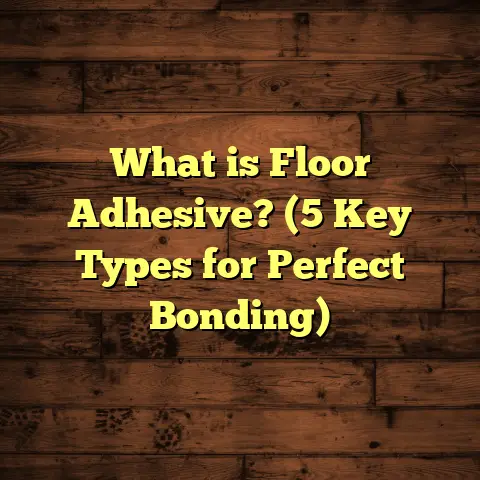What Is a Natural Stone Floor? (5 Benefits for Your Home)
Have you ever stopped to think about what really makes a floor more than just a place to walk? When I first started working in flooring, I thought floors were just functional—something to cover the ground. But over time, I discovered they can be so much more: a foundation for style, comfort, and even a reflection of nature itself. That’s where natural stone floors come in. If you’ve ever admired those stunning marble countertops or the rugged beauty of slate patios, you might wonder what it would be like to have that kind of elegance underfoot every day.
So, what exactly is a natural stone floor? And why do so many homeowners and designers swear by it? Let me walk you through my journey with natural stone flooring and share some insights and experiences that might help you decide if it’s right for your home.
What Is a Natural Stone Floor?
When I say “natural stone floor,” I mean flooring made from real stones quarried from the earth, then cut, shaped, and polished into tiles or slabs suitable for walking on. Unlike engineered stones or synthetic materials, these floors carry the original texture, color variations, and imperfections that come from their natural formation.
Some of the most popular types I’ve worked with include:
- Marble: Known for its smooth surface and elegant veining. It’s classic but needs careful maintenance.
- Granite: Extremely durable with a speckled appearance; great for high-traffic areas.
- Slate: Rough texture with earthy colors; slip-resistant and great outdoors or in wet areas.
- Travertine: Warm tones with natural holes that give a rustic look; requires filling holes during installation.
- Limestone: Softer stone with subtle colors; less resistant to acidic spills.
Each stone type has its own story because they form under different geological conditions—some from volcanic activity, others from sedimentary deposits. This means every tile is unique. When I install natural stone floors, no two tiles are quite alike, which adds personality to every space.
In one project, I used marble in a client’s bathroom. The veining pattern was so striking it looked like abstract art laid out across the floor. Another time, I installed slate in an outdoor patio where its natural texture prevented slipping even when wet. These personal experiences helped me understand how versatile natural stone can be.
Comparing Different Natural Stone Options: What I’ve Learned
At first, I was just excited about how beautiful natural stone looked. But as I worked more with different types, I started noticing practical differences that changed how I recommended stones for certain rooms.
Marble: Beauty with Caution
Marble is often the go-to when someone wants luxury. Its glossy finish and cool feel underfoot are unmatched. However, marble is relatively soft compared to other stones. In kitchens or dining rooms where spills happen frequently, acids from wine or citrus can etch the surface if not cleaned quickly.
I remember a client who loved marble for their dining room floor but was frustrated when wine stains appeared despite sealing. We had to reseal the floor multiple times to keep it looking fresh. So while marble offers stunning aesthetics, it demands more care.
Granite: Tough and Timeless
Granite is a real workhorse. It’s one of the hardest natural stones available and resists scratches and heat incredibly well. I installed granite floors in a busy restaurant kitchen once, and even after years of heavy use, the floor looked almost new.
Statistically speaking, granite has a Mohs hardness rating of 6-7 (out of 10), making it significantly more scratch-resistant than marble (which rates around 3-5). If you want something durable with less worry about damage, granite is a solid choice.
Slate: Rustic and Practical
Slate has this rugged charm that’s hard to describe until you see or feel it. Its textured surface naturally hides dirt, which makes it great for mudrooms or entryways. Plus, slate tiles come in various shades from dark gray to rusty reds.
One time, I installed slate in a family’s backyard patio area where kids often played barefoot. The natural slip resistance gave peace of mind to the parents. Slate also holds up well against weathering, which makes it excellent outdoors.
Travertine: Warmth with Personality
Travertine’s porous surface and warm colors add character to any room. It feels welcoming in living rooms or hallways. But because of its holes and pits formed by mineral deposits over millennia, it needs filling during installation to make a smooth surface.
I find travertine works best in low-traffic areas or rooms where you want that vintage look. It’s softer than granite but more durable than marble.
Limestone: Soft Elegance
Limestone is subtle and soft underfoot but can be vulnerable to acid damage like marble. It’s great for bedrooms or spaces where foot traffic is lighter.
In one bedroom project, limestone created a peaceful vibe that blended well with neutral decor. Just make sure to seal it well if you want to avoid staining.
What Makes Natural Stone Floors Different from Other Flooring Types?
As someone who’s installed hardwood, laminate, vinyl, ceramic tile, and more, I’ve learned how each material has its strengths—and limits.
- Hardwood offers warmth and a classic look but is prone to scratches and water damage.
- Laminate mimics wood or stone but can peel or chip over time.
- Vinyl is affordable and water-resistant but doesn’t have the same longevity or luxury feel.
- Ceramic tile is durable but can feel cold or hard underfoot.
Natural stone stands apart because it combines durability with unique aesthetics born from nature itself. Plus, no two stone floors are identical—something synthetic options struggle to replicate.
5 Benefits of Natural Stone Floors for Your Home
Let me break down five key benefits I’ve observed over years of working with these materials:
1. Durability That Stands the Test of Time
I’ve seen kitchens with granite floors still looking great after decades without major repairs. Natural stone is incredibly strong due to its dense composition. For example:
- Granite’s compressive strength ranges from 100 to 250 MPa (megapascals), making it one of the hardest building materials.
- Marble scores lower but still holds up well under moderate traffic.
This strength means less worry about dents or cracks compared to wood or laminate floors. For busy households or commercial spaces, that long-lasting quality saves money on repairs and replacements.
2. Stunning Aesthetic Appeal
Natural stone’s color variations and textures create floors that are both unique and elegant. From my installations:
- Marble veining patterns add sophistication.
- Slate’s earthy tones bring warmth.
- Travertine adds vintage charm.
According to a survey by the National Association of Home Builders, 63% of homeowners say flooring materials impact their perception of home quality—natural stone often ranks high on this list.
3. Boosts Property Value
Homes with natural stone floors tend to attract premium buyers who appreciate quality finishes. I’ve seen houses sell faster when stone flooring was part of the package.
Remodeling Magazine reports that natural stone flooring returns around 70-75% of its cost on resale—higher than hardwood or carpet in many markets.
4. Environmentally Friendly Option
Natural stone is mined directly without heavy chemical processing used in synthetic materials like vinyl or laminate. Since stone floors last for decades, there’s less waste compared to materials needing frequent replacement.
I once worked on an eco-conscious renovation where reclaimed slate was used to give new life to old materials without new quarrying—combining sustainability with style.
5. Naturally Cool Underfoot
In warm climates especially, natural stone floors help keep interiors cooler without extra energy use. Their thermal mass absorbs heat during the day and releases it slowly over time.
This property can reduce air conditioning use—something my clients in southern states value highly during summer months.
Real Stories from My Projects
To give you a clearer picture, here are some real-world examples:
Project 1: Family Kitchen with Granite
A family wanted a kitchen floor that could handle spills, dropped pots, and heavy foot traffic from kids and pets. We chose polished granite tiles with a medium finish for slip resistance.
Years later, they told me how happy they were that their floor still looked great despite everything life threw at it—no cracks, no stains, just solid performance.
Project 2: Living Room Elegance in Marble
For another client who loved classic design, marble was perfect for their living room floor. We did extra sealing steps to protect against wear and tear.
They enjoy hosting dinner parties where guests often compliment the floor’s beauty and feel beneath their shoes. The client even told me that family photos look richer thanks to the elegant backdrop marble provides.
Project 3: Outdoor Slate Patio
A couple wanted an outdoor space safe for kids while still stylish enough for entertaining guests. Slate’s rough texture fit perfectly.
Despite rain and sun exposure for years, the patio remains slip-resistant and vibrant—showing how slate handles outdoor conditions better than many other stones.
How Costs Stack Up: Using FloorTally in My Workflow
Budgeting can be tricky with natural stone because costs vary based on stone type, quarry origin, tile size, installation complexity, labor rates locally—and even waste factors during cutting.
Early in my career, clients would get surprised by unexpected expenses after initial quotes because we hadn’t accounted for these variables properly.
That changed when I started using FloorTally—a tool that lets me enter project details like square footage, preferred stone type, local labor rates, installation methods (like mortar vs adhesive), and waste percentage allowances (usually around 10%).
FloorTally then generates detailed cost estimates instantly:
- Material prices based on current local market data.
- Labor costs broken down by installation complexity.
- Waste factors included upfront to avoid surprises.
For example: A living room with 300 sq ft of travertine might show $20 per sq ft material cost + $10 per sq ft labor + 10% waste = total estimate around $6,600.
This transparency helps me set clear expectations early on—and clients appreciate seeing exactly what drives costs instead of vague ballpark numbers.
Maintenance Tips Based on What I’ve Seen Work Best
People often ask me if natural stone floors are hard to maintain. The truth? It depends on the type of stone but generally isn’t as scary as people think if you follow simple routines:
- Use pH-neutral cleaners designed for stone surfaces.
- Avoid vinegar or acidic cleaners that can etch marble or limestone.
- Clean spills promptly—especially oil or wine—to prevent stains.
- Use soft cloths or mops instead of abrasive scrubbers.
- Reseal floors every 2-3 years depending on traffic.
Once clients establish these habits early on after installation, their floors stay beautiful for years without major issues.
Common Questions I Get About Natural Stone Floors
Q: Can natural stone crack?
Yes—but usually due to improper subfloor preparation or heavy impacts like dropping very heavy objects. Proper installation is key to preventing cracks.
Q: Are stone floors cold in winter?
They can be unless paired with radiant heating systems beneath. Many homeowners install underfloor heating for comfort in colder climates.
Q: How slippery are stone floors?
It varies by finish—polished marble can be slippery when wet; honed or textured slate offers better grip.
Q: Does natural stone fade?
Generally no if sealed properly; however prolonged UV exposure outdoors may cause slight color changes over decades.
Natural stone floors combine durability with beauty and have unique benefits that synthetic options often lack. They come in many varieties suited for different tastes and practical needs—from elegant marble halls to rugged slate patios.
If you want a floor that tells a story through its patterns while standing strong through daily life’s challenges, natural stone might just be worth considering. And tools like FloorTally can help make planning these projects easier by giving realistic cost snapshots upfront.
Have you ever thought about installing natural stone floors? Or maybe you already have some? I’d love to hear what your experience has been like!





